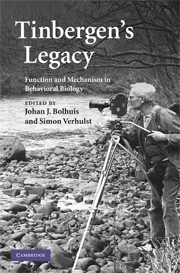Book contents
- Frontmatter
- Contents
- Contributors
- Foreword by Aubrey Manning
- Preface
- 1 On aims and methods of ethology
- 2 Tinbergen's four questions and contemporary behavioral biology
- 3 Causation: the study of behavioral mechanisms
- 4 Tinbergen's fourth question, ontogeny: sexual and individual differentiation
- 5 The development of behavior: trends since Tinbergen (1963)
- 6 The study of function in behavioral ecology
- 7 The evolution of behavior, and integrating it towards a complete and correct understanding of behavioral biology
- 8 Do ideas about function help in the study of causation?
- 9 Function and mechanism in neuroecology: looking for clues
- References
- Index
Foreword by Aubrey Manning
Published online by Cambridge University Press: 19 February 2010
- Frontmatter
- Contents
- Contributors
- Foreword by Aubrey Manning
- Preface
- 1 On aims and methods of ethology
- 2 Tinbergen's four questions and contemporary behavioral biology
- 3 Causation: the study of behavioral mechanisms
- 4 Tinbergen's fourth question, ontogeny: sexual and individual differentiation
- 5 The development of behavior: trends since Tinbergen (1963)
- 6 The study of function in behavioral ecology
- 7 The evolution of behavior, and integrating it towards a complete and correct understanding of behavioral biology
- 8 Do ideas about function help in the study of causation?
- 9 Function and mechanism in neuroecology: looking for clues
- References
- Index
Summary
As a former student of Niko Tinbergen, it is a pleasure to introduce this collection of papers written to commemorate the 40th anniversary of his classic paper on the “four questions” (Tinbergen, 1963, this volume). First a little history, because we need to remember the context in which Tinbergen came to write this memorable paper. It was designated as a salute to Konrad Lorenz, old friend and colleague, for his 60th Birthday, but its timing and content signified much more than this. During the late 1950s and early 1960s ethology was evolving rapidly and going through some turmoil. I suppose the original framework of “classical ethology” as it appeared to most of us at the time was encapsulated in Lorenz's 1950 Society for Experimental Biology Symposium paper and Niko's The Study of Instinct (1951). The number of people calling themselves ethologists was increasing rapidly especially in Germany, the Netherlands and Britain and many of them had close connections with Lorenz's and Tinbergen's groups. We were aware that this “new” approach to the study of animal behavior had plenty of antecedents both in Europe and in the USA. Tinbergen himself lists Whitman, Heinroth, and Verwey; nevertheless, I don't think we can be blamed for regarding it as new. After the Second World War, animal behavior was emerging from decades when American experimental psychology held sway – everyone should dip into Munn's (1950) heroic text to get some flavor of that influence – and Lorenz and Tinbergen seemed to signal a new era.
- Type
- Chapter
- Information
- Tinbergen's LegacyFunction and Mechanism in Behavioral Biology, pp. ix - xxPublisher: Cambridge University PressPrint publication year: 2009
- 2
- Cited by



